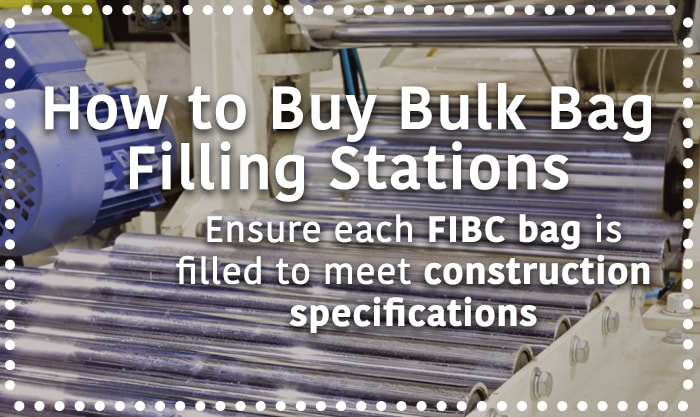
Bulk bag filling stations are machinery that fill your FIBC bags on an assembly line, allowing you to create products and ensure each bag is filled to meet construction specifications. You can incorporate bulk bag loaders and bulk bag unloaders in your development without concern because FIBC filler stations can meet regulations from the FDA, USDA, 3-A and many other international organizations.
With reliable bulk bag loaders and unloaders, bags are filled to reach specific volume or weight requirements, and the systems can be completely automatic, helping ensure you limit dust or other contamination and that bags are properly filled, measured and moved down the line efficiently.
Types of Bulk Bag Handling Equipment
If you have been tasked with finding reliable FIBC handling equipment, you have nothing to worry about. You might be in the best place you can be when looking to buy bulk bag filler equipment. The hardest part for you when it comes to FIBC handling equipment is not how to find the right bulk bag loader and bulk bag unloader. Rather, it’s knowing which type you want. You have more choices today when it comes to FIBC handling equipment than ever before, and you want to choose the equipment that best meets the requirements of your specific business.
The FIBC handling equipment market is extremely diverse, and there are bulk bag loader and unloader options to meet just about any need, with many easy customizations available for you right now.
If you’re going into your search for a bulk bag loader or unloader without any preconceived notions about what you need specifically, the range of options might seem a little intimidating. We want to be sure to get you the right FIBC handling equipment for your needs, so here are all the basics to help you make your determination.
FIBC filler equipment runs the gamut from an individual, manual unit where a worker opens and closes a feed valve on their own to a fully automated system that collects bags, fills them, secures them and moves them down a production line — and there’s everything in between, too. So how do you know which bulk bag loader and unloader is right for you?
Considering different types of bulk bag fillers and stations is really about considering the different elements of the modern FIBC filler. Here are a few broad categories or considerations for you when determining when and what to buy for bulk bag filler equipment:
- Bases. A bag filler base provides a secure place to do your work, and it must be firm to ensure bags are properly filled without the risk of spilling. The better your base, the faster the fill rate you can support, too. The big considerations here are if you’re using a strong platform for heavy fills, a roller conveyor for high-volume fills or a vibratory densification system that will allow you to use a denser bag.
- Controls. Manual and automatic systems range significantly. You’ll want to match these controls to your needs and overall production volume. A deeper dive into this is below.
- Fill heads. Fill heads allow you to integrate any bulk material into your filling processes. There are many basic fill heads that use a simple spout to help measure out and deposit materials. Depending on your application, you may need additional dust protections, adaptors to fill other container types, strong valve controls and fill heads that can move to make it easier on your employees.
- Framework and hangers. The framework and hangers concern the physical structure of your filling equipment. Frameworks should be designed to support significantly more weight than your bag maximum and have multiple design options to meet extra strength or sanitation needs. Loop hangers not only need to be strong, but also adjustable, and clamping options can make automation simpler or allow your workers to easily make other changes.
Remember you can always contact one of our friendly and knowledgeable staff at Midwestern Bag & Supply for clarification regarding any of these categories.
How to Buy Bulk Bag Filling Stations
Now that you know some of your options when it comes to FIBC handling equipment, what’s the approach you should take when deciding on what type of bulk bag loader and bulk bag unloader you are going to buy?
It’s best to consider your entire application and try to anticipate future needs when you’re trying to finalize what bulk bag filler to purchase. We wanted to leave you with a few final thoughts on additional considerations and questions to ask for your FIBC filler.
We hope these will help you address standard needs such as the level of automation, filling and unloading operations, plus support for upstream and downstream equipment:
-
What’s is your need capacity?
There are two very important questions to answer when you’re looking at bulk bag filling stations:
- How many bags do you think you’ll need to fill each week for the coming years?
- When do you think you’ll invest in a new filler or an upgrade to an FIBC filler?
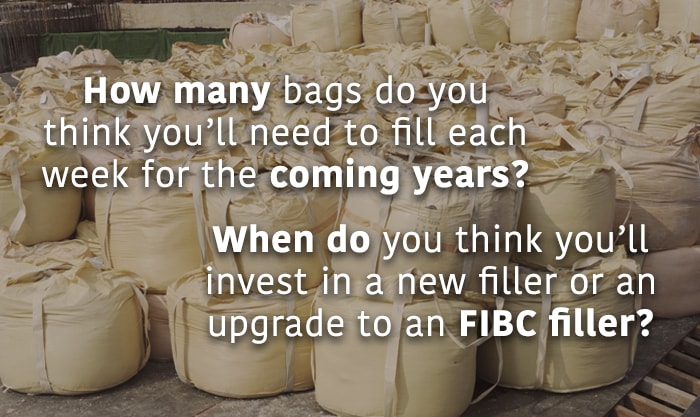
These two answers will help you choose a filling station that’s designed to keep up with your demands through a complete lifecycle. You’ve been looking at costs of these stations, so you know it’s cheaper to buy a higher-rated station that’s designed for greater filling than it is to buy two options, each with a shorter projected lifecycle.
Consider the volume you need and be sure you’re buying a machine that exceeds that need — you always want to plan for future growth. The maximum you want is typically a great guide for how much automation you’ll need for your fill station. If you’re on the lower end of need, such as a couple bags per day or week, then you can save a lot on your costs by choosing a manual model when you buy bulk bag filler machinery.
Capacity also touches on the volume and weight requirements of your bags. So, if you’re filling just a few bags and they have light load requirements, you can choose a model that saves you money with lighter weight frames. Pair that with a minimal filling need, and you could choose a two-post unit that supports your feed piping and then provides a strong base. Simple fill head adjustments can ensure the chute vent maintains its clearance with a manual feed.
Combine weight and fill with the automation needs, and you’ll also know what auxiliary equipment you require. Heavy, constant filling bags will necessitate a conveyor belt system, while fewer fills per day can allow you to use forklifts or hand trucks to move your bags around — stick to a forklift when working with heavy bags or if you have safe clearance space.
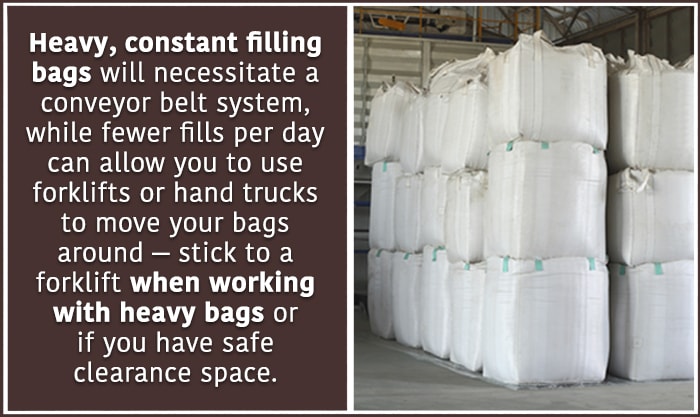
-
What can your workers do?
Building on the size consideration for conveyor belts and forklifts is a broader look at your workforce and what they’ll be able to do with the bags you’re filling. When many companies consider how to buy bulk bag filling station equipment, they often overlook the human elements.
Always make sure your FIBC fillers will not lead to employee fatigue and increase the risk for injury by being too demanding.
Some of the major considerations include what machinery you’re using to move the bags before and after being filled, how many touch points each bag needs during creation, the layout of your equipment and how often it operates.
Standard bulk bag filling stations will be too tall for your staff to reach feed tubing without standing on platforms or ladders. When you introduce automation, such as a conveyor belt, then it becomes even more difficult to access to the input, feed tube, chute and vent of your equipment.
Do what you can to limit hard-to-reach elements or the need to make adjustments. This can be using a feed system that automatically adjusts as bag sizes change or the use of safety features like fill heads designed to adjust and lower down to floor level, making any operator actions simpler and safer.
For high-volume output, you’ll also want to limit the strain and repetition of your employees. The perfect place to start is with semi-automated and fully automated equipment that can handle placing pallets on conveyors, triggering material delivery, clipping or releasing bag hooks, plus many other standard actions.
-
Is your source and filler based on your feed material guide?
Your ability to feed material through your system is a major limit to your production capabilities. Feed material will determine how fast your upstream equipment can deliver a consistent volume, which in turn impacts line efficiency, filling accuracy, capacity and overall speed.
If you want to use an automated platform, you’ll need a high-capacity feeding system that uses multiple avenues for delivering and maintaining a consistent flow. Look for upstream equipment that relies on accurate metering tools or gravity-based systems to deliver filler in a sufficient manner during the entire operation.
One of the main settings we see is a gravity-feed material application that relies on storage containers or vessels located above your filler equipment. It times loads and capacity with the production system to maintain a consistent flow of materials to containers. These systems typically can adjust flow from a steady river to a small dribble rate to hit a precise weight.
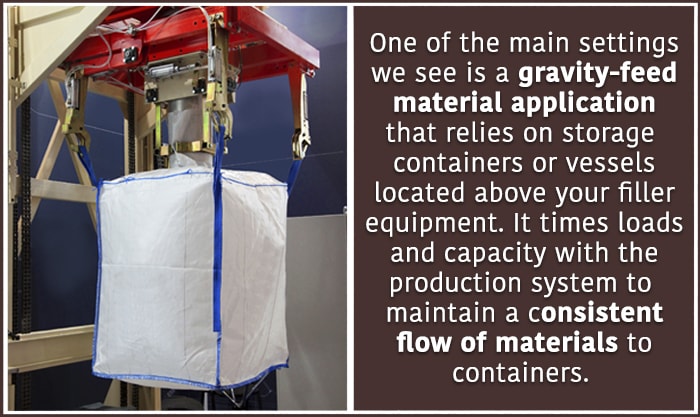
Check out the capacity and different volume/flow capabilities. Look at slide gates and precise control valves to ensure you’re not over or under-filling any bags with that machinery.
This comes back to materials because not all systems should be used with gravity. Liquids that are especially viscous, solids that clump easily and fine particulates that may float in the air are all poor candidates for using a gravity-feed system.
If you have one of these — or any of the other fill materials that are non-free-flowing — select a metered feeding system so you are accurately filling each bag, each time. Systems like this will rely on a variety of systems that don’t need gravity’s support, including:
- Bucket elevators
- Drag disks
- Rigid augers
- Rotary airlocks and valves
- Screw conveyors
- Screw feeders
- Other flexible delivery mechanisms
Differing mechanisms for the metered filling system can cause different results in your production line. The main consideration is that some of these options will need a significant amount of space above the filler, especially rotary airlock valves. You’ll be making some choices in headroom where flexible mechanisms may even reach your ceiling joists, but this can be balanced with the reduced need for other equipment such as flow-control valves on the side of your filling machine.
Feed materials also have a wide range in weight. If you’re using extremely heavy or dense filler materials, then you’ll need to make sure the infrastructure to feed these filling machines is significant and capable of enduring that weight day in and day out.
-
What’s the best way to reduce contamination when it comes to your FIBC handling equipment?
Which bulk bag filler is designed for your industry and can address the contaminants common in your warehouse or production facility?
Every filler you’ll come across will have a spout seal, typically inflatable, that is designed to keep the bag spout steady and in place when the filling process is happening. In many situations, that might be all you need because of the nature of the fill.
However, if you work in an environment that is full of contaminants, which dust is especially common, you should consider a system that works to eliminate this risk. Look for a unit where the fill head uses a venting system and dust collection system to filter the air and dust. There should also be a way to vacuum up any dust or particulates in the ambient environment.
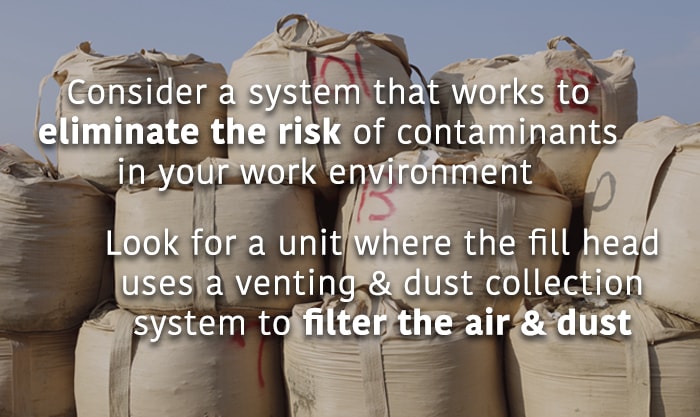
Make sure you have a vacuum system that can operate when the fill head is disconnected, changed, cinched or adjusted.
The more risk of contamination from your environment or the greater tolerance you need during the fill, the stronger the vacuum and filter system you’ll need.
Putting It All Together
Today’s bulk bag filler station and equipment can be customized to meet almost any need and situation. It’s best to bring all of your specific requirements together and reach out to manufacturers and suppliers to make sure that filler design is best for your production facility.
Whether you have tight controls for hygiene, need multiple filler capabilities, are under intense regulator pressures or need equipment that’s not used often, the OEM is often your best bet for determining the right equipment for your needs.
Important Things to Keep in Mind
You want to know what bulk bag filler meets your needs and your budget, and Midwestern Bag & Supply wants to help you find the right fit. We know a lot about getting the perfect FIBC filler for your bulk bag needs. Here are a few details that often slip through the cracks when people start looking at how to buy bulk bag filling station equipment:
- Outline growth and functions
Many bulk bag filling stations support multiple modes of delivery. That means your bag filler may also be able to support boxes, crates, drums and other containers with the same equipment and controls. Multi-function filling equipment is common in the industry and is especially useful in areas where space is limited or if your operations focus on individual production runs at their own designated times.
Adjustable filling chutes and discharge ports can make it especially easy for your team to shift from bags to boxes or drums. If you choose automated options, you can even set the machinery to automatically rotate and change to your conveyor belt to deliver materials based on container layout. This even can include a smart chute head that will fill multiple drums secured on a pallet, without spilling or spreading materials.
Look at the control systems and supported fill adaptors to make sure your choice is able to meet all of your production and function needs. If you have expansion plans, include these in your filler service selection.
- Check your requirements
Your industry has a wide range of regulations and requirements that you must verify compliance with, plus your customers will have their own sanitation requirements. Equipment needs to be designed to meet compliance demands and limit contamination, while exceeding customer demands.
Every time your bag is improperly filled, you run the risk of having to process a return, refund money and have your reputation harmed. The best place to start is with federal and industry requirements. These requirements can be simple from having ground and polished welds in every joint, to specific requirements like the USDA Quality Grading & Inspections list.
The agency governing your materials and applications will have specific guidance you need to follow.
Need Help With Your Bulk Bags or FIBC Handling Equipment?
We know there’s a lot of information here with respect to FIBC bulk bags and FIBC handling equipment, but we think we can make it simple. If you need bulk bags or a bulk bag loader or unloader, we are sure we can find the right products for you. It’s what we do every day.
When you need bulk bags, we make it easy and convenient to order. We are also available Monday through Friday from 8am to 5pm CST to answer any questions you might have.
You can use the contact form on our website to get in touch with us. If you prefer to speak with us directly, give us a call at 877-311-3422 anytime during our operating hours, and you’ll see why we’re so proud of our customer service.


 Copyright © 2025 Midwestern Bag. All Rights Reserved.
Copyright © 2025 Midwestern Bag. All Rights Reserved.